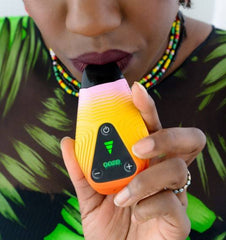If you’re on the hunt for the perfect marijuana strain to cure your woes, start by looking into the three main subspecies of cannabis: indica, sativa and hybrid. The difference between sativa and indica comes down to the physical attributes of the plant itself, as well as the way they affect the body and mind. Depending on how you want to feel and what mental and physical troubles you want to address, a sativa, indica or hybrid may be best for you. Let’s dive in to what makes these cannabis subspecies different!
What are the subspecies of cannabis?

There are three main species of cannabis: cannabis indica, cannabis sativa and hybrids, which occur when indica and sativa plants are bred. All of these subspecies will look different physically and produce different effects from each other. Cannabis sativa plants tend to be much larger, taller, less dense, and with narrower leaves than cannabis indica. Because of this, sativa grows better in warm and humid clients, and indica can be a bit more temperamental to grow because of its dense, fuller leaves.
Due to heavy crossbreeding in the industry, it’s safe to say most strains nowadays are some sort of hybrid between sativa and indica. These plants will all look different and may not be easily recognizable as sativa- or indica-dominant.
What are the different effects of indica, sativa and hybrid?
The effects and benefits vary between both indica and sativa, and of course, hybrids. Sativa strains typically will give the user more of a boost of energy, enhancing creativity, motivation and focus, and produce more of a cerebral high. This is why you might feel more high when you smoke sativa strains. Indica, on the other hand, produces more of a body high, a relaxed and euphoric feeling, and might make you feel sleepy.
Hybrids can be totally different depending on how they’re bred and what percentage indica and sativa they are. They can feel like an upper, like a sativa, or a downer, like an indica. The effects of hybrid strains are often categorized based on the dominant terpenes since those are what mainly determine the experience (this is true for sativas and indicas as well).
Hybrid strains can be indica-dominant, sativa-dominant, a 50/50 blend of both, and have a high THC content or a high CBD content. High THC percentage will provide more of a cerebral effect, making you feel more high, whereas a hybrid strain with a higher CBD content will produce a more mild high, making it a good option for beginners.
What are the different uses for indica, sativa and hybrids?
Sativa Uses
Because sativas promote more of an energized feeling, recreational uses typically involve outdoor activities, social events and creative projects. Many sativa strains might make you feel talkative, while others are going to help get the creative juices flowing, so look into the effects of each strain.
Medicinally, sativas can help with depression since they provide that boost of energy and motivation. Because they might also help with focus, those with ADHD/ADD can benefit from sativas when trying to finish a project distraction-free.
Popular examples of sativa strains are Green Crack, Jack Herer and Sour Diesel.
Indica Uses
Indica strains tend to be used less recreationally than sativas and more medicinally, but they can still enhance the experience if you just want to relax on the couch, do some yoga or chill out in the bath after a long day.
On the flip side, medicinal uses for indica tend to be much more abundant than sativas. They also greatly benefit those struggling with anxiety, depression and stress, but are especially effective at easing chronic body pain and insomnia. Because of this, indica strains are definitely your “nighttime” strains—you wouldn’t want to try one before tackling a big project. Indicas can also help with a lack of appetite as they are more likely to give you the “munchies” than sativas, so they’re often used by cancer patients and those with other diseases that cause weight loss and lack of appetite.
Famous indica strains include Northern Lights, Granddaddy Purp and Afghan Kush (anything with ‘Kush” in the name is probably an indica or indica-dominant hybrid).
Hybrid Uses
Because hybrid strains vary so much in physical and mental effects, the umbrella for ideal uses is huge. Depending on terpenes present in each hybrid strain, they can minimize anxiety, depression, stress, insomnia, pain and more.
Familiar hybrid strains include Blue Dream, AK-47 and Gorilla Glue, but there really are an infinite amount of hybrid strains out there today.
Do you consume indica, sativa and hybrid strains differently?

You can enjoy these cannabis subspecies any way you prefer; there aren’t necessarily ideal consumption methods for each. All of these different strains can be smoked, vaped or consumed orally with edibles.
Dry herb vaporizers are great for consuming raw flower because they tend to be cleaner and healthier than lighting the flower and burning it, and it’s more efficient, so your bud will go further. We love the Brink vape for flower because it’s super simple to use, and it uses sub-ohm heating, meaning it heats the material evenly and at a lower temperature so you can taste all the terpenes without any burnt flavor.
If you prefer to pack up a water pipe or bowl with your flower, make sure you have a quality grinder so your bud is nice and fine. This will help enhance terpene flavors as well and help you get the most out of your smoke sesh.
Although defining sativa, indica and hybrid strains is important for understanding how strains might affect you, these subspecies don’t make up the entire puzzle. More recent research has shown that this isn’t a perfect way to categorize strains anymore because of all the crossbreeding. Terpenes play a bigger part in the effects and consumers should educate themselves on all parts of the plant if they want to really understand the effects of a particular strain.
It’s also important to keep in mind that each individual will react differently to different strains, so it takes actually trying out the strain to determine your preference on different terpenes. Still, it’s good to know in general what kind of high you’re going for—an upper or a downer or something in between—before selecting a strain. Sativa, indica or hybrid is a good place to start!





